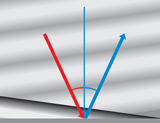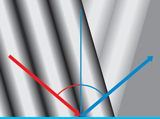Module 8—Mechanical Waves
 Read
Read
In light of what you have just done, review “Waves and Rays” on pages 397 to 399 of your textbook.
 Module 8: Lesson 2 Assignment
Module 8: Lesson 2 Assignment
Remember to submit the answer to TR 2 to your teacher as part of your Module 8: Lesson 2 Assignment.
 Try This
Try This
TR 2. For the following diagrams, sketch in the normal line and the incident and reflected rays. With a protractor, determine the angle of incidence and angle of reflection. Use the Water Reflection simulation to check your answer. In each of the images below, the reflected wave is highlighted and the incident wave appears in the background. Be careful—remember that the ray is perpendicular to the wave!
 Self-Check
Self-Check
SC 3. Identify which of the following diagrams are the ray diagrams drawn correctly. A correct ray diagram has rays that are perpendicular to the wave fronts. For diagrams that are incorrect, draw in the corrected rays.
 Self-Check Answers
Self-Check Answers
SC 3.
- correct
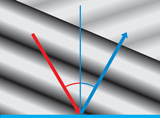
- incorrect
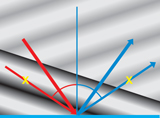
- correct
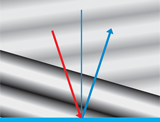
- incorrect
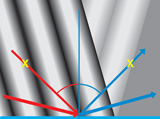
 Module 8: Lesson 2 Assignment
Module 8: Lesson 2 Assignment
Remember to submit the answer to TR 3 to your teacher as part of your Module 8: Lesson 2 Assignment.
 Try This
Try This
TR 3. Draw a ray diagram to show the reflection of a wave that is incident to a surface at an angle of 20.0°. Use the Water Reflection simulation to verify your answer.
 Self-Check
Self-Check
SC 4. Draw a ray diagram to show the reflection of a wave that is incident to a surface at an angle of 0°.
 Self-Check Answers
Self-Check Answers
SC 4.
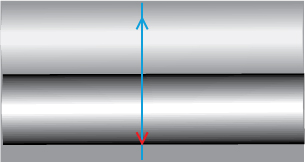
Huygens’ Principle and Reflection
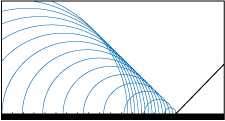
Christian Huygens was a Dutch physicist who lived during the seventeenth century. Huygens described an elegant and conceptual model of how waves travel. He stated that any wave front can be thought of as a series of points. Each point acts as a source of tiny secondary waves, called wavelets, which propagate outward in concentric circles at the same speed as the wave itself. The line tangent to the wavelets represents the wave front. This idea, called Huygens' Principle, can be used to explain reflection.
wavelet: a secondary wave
Imagine a wave front that is travelling towards a surface. This wave front can be viewed as a series of point sources, each emitting wavelets. As each point source reaches the surface, it emits wavelets. The wavelets are emitted in sequence over a given time interval—the first wavelets will have propagated the farthest, followed by the wavelets from the second point source, followed by the wavelets from the third point source, and so on. If the line tangent to the wavelets is drawn, you can see that the reflected wave front leaves the surface at the same angle as the incident wave front approaches it. The series of diagrams below shows a wave front reflecting from a surface over time.

 Watch and Listen
Watch and Listen
See how wave reflection occurs according to Huygens’ Principle in this animation. Notice how the wave fronts from several point sources add up to a straight wave front. You will learn more about addition of waves in the next lesson.



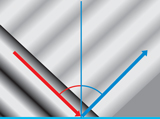
.jpg)
